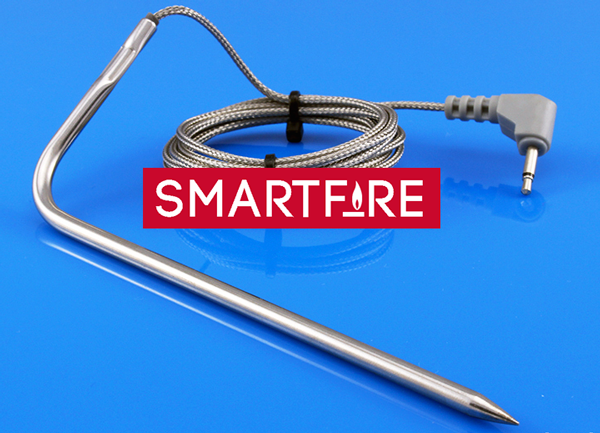Cooking should be an enjoyable experience, and you don't want to spend your time worrying about meat temperature. This can cause unnecessary stress, not to mention the health and safety hazard. For everything you need to know about temperature probes, read on!
What is a Probe Thermometer Used For?
For BBQ smoking probes are used commonly for monitoring the ambient temperature of the smoker grill or the food protein that you are cooking.
It's important to be able to keep an eye on the BBQ smoker temperature. You'll be wanting to confidently cook at the ambient temperature that will suit your recipe. Sometimes you'll be wanting to keep low and slow at around 110C / 230F for long cooks. Other times you'll be wanting to cook hot and fast around 135-150C / 275-300F. Knowing and recording the pit temperature in an easy to read graph helps you know whether any temperature spikes or dips adversely affected your cook.
Food probes are mainly used to know when dinner is ready! You want the protein to be safely cooked to food standard internal temperatures and similarly you don't want to overcook the food. Safely monitor your food's temperature throughout the cooking time to ensure you don't overcook it. It's also important to use when you cool, re-heat, and thaw foods to monitor and ensure safe temperatures. Depending on the thermometer, it can give you accurate readings during BBQ cooking, in the oven and on the stove top.

Source - Smartfire
How to Use a Temperature Probe
Using a digital probe food thermometer with your BBQ smoker makes it easy to confirm that your meats are at a safe temperature. Our guide will walk you through the process of using the probe correctly.
-
When you start your smoker, insert your digital meat probe into the deepest part of your cut of meat. For steaks or a roast, this area is usually in the middle. Poultry is deepest along the depth of the inner thigh. Avoid coming into contact with the bones because it can give you an inaccurate readout on your cooking probe. Insert your WiFi BBQ temperature probe until it's in the middle of the meat. Don't go all of the way through.
-
If you have a dual system with a BBQ probe, you can attach the barbecue temperature probe directly to your grate. It hooks up to your control system, and you can seamlessly monitor both the smoker temperature and the meat temperature. It's best to have the BBQ probe inserted well through the clip so the clip is resting on halfway mark to the rear third of the clip - this avoids the clip interfering with readings.

Source - Smartfire
-
Read out the temperature showing up on your digital temperature probe. Ideally, you'll be able to sit away from your smoker and monitor your temperatures. The digital readout can tell you at a glance what your temperatures are, and you can adjust accordingly.
- When your food reaches the desired temperature range, it's safe to eat. The Smartfire BBQ smartphone app enables you to choose your protein, cut and desired doneness and then will tell you the target temperature in either Celsius or Fahrenheit so you don’t need to remember everything!
How to 'Calibrate' BBQ Temperature Probes - IE Testing For Accuracy
To test probes for accuracy and/or issues, we recommend using a cup of hot water and all the probes plugged into your BBQ temperature system. Check this article for a full walkthrough.
Different Types of Cooking Temperature Probes
You can split cooking temp probes into four broad categories. They include:
- Resistance Temperature Detector - These thermometers read the resistance levels of film or wire wrapped around a glass or ceramic to the temperature. It's very accurate, but it's also the most expensive.
- Thermocouple Probe - These are the fastest types of instant-read probes with a two-to-five-second readout. The probe tips feature two fine wires. The intersection point temperature goes to a digital thermometer, though it does require careful calibration to ensure the reading is still accurate.
- Semiconductor-Based Sensor - This probe displays the average temperature it picks up along its bimetallic coil. It can take up to 20 seconds to get a readout, and they work best on more substantial foods that can be probed deeply. These probes need at least two or three inches to get an accurate temperature.
- Negative Temperature Coefficient (NTC) Thermistor - This probe provides precise and reliable temperature data according to resistance changes in the protein. When the temperature goes up, resistance falls, resulting in fast and accurate temperature readings across the entire temperature range that BBQ cooking typically involves. Smartfire uses factory calibrated and waterproof NTC Thermistors to provide optimum accuracy and responsiveness.
You want to have a quality probe thermometer around for food safety. Our customers know that Smartfire offers some of the best cooking probe thermometers in Australia, United States, United Kingdom and more broadly Europe. If you'd like your own, browse our store today.



Share:
A handy guide to total fire bans (TOBAN) and BBQ in Australia
Christmas Ham Recipe